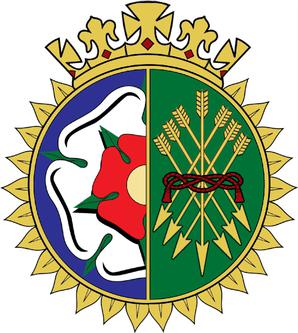Top Qs
Timeline
Chat
Perspective
Queen Mary's Grammar School
Grammar school with academy status school in Walsall, West Midlands, England From Wikipedia, the free encyclopedia
Remove ads
Queen Mary's Grammar School (QMGS) is a boys' grammar school with academy status located on Sutton Road, Walsall, England, about a mile from the town centre and one of the oldest schools in the country.[1] The sixth form is coeducational.
Remove ads
Admissions
Admittance to the school is by entrance exam taken at the age of 10/11. Since September 2020, 180 pupils enter the school in September each year, increased gradually from 96 in September 2012. The school has grown from 718 in 2011 to 1,305 in 2022.[citation needed]
There is separate admission into the Sixth Form based on academic performance at GCSE, requiring a minimum score of 54 points in GCSEs and least a 7 in the applicant's chosen subjects. As of 2019, there are over 400 students on roll in the Sixth Form. At this stage of the school, girls are also admitted.
Remove ads
History
Foundation
The school was founded in 1554 by George and Nicolas Hawe, two leading townsmen, with Queen Mary I as its royal patron and benefactor.[2] At the time it had about sixty pupils, all boys, and taught Classics almost exclusively.
New sites
The school has grown significantly since its foundation and moved three times. Originally housed in an old town guild-hall near St Matthew’s Church, it moved to Park Street in 1811, into new buildings in Lichfield Street in 1850 (a site now used by Queen Mary's High School) and finally to a purpose-built school on the Mayfield site in 1965.[3]
Remove ads
Academic performance
Queen Mary's performs very well in exams across the board, with consistent success in the sixth form.[4] In 2007, the school became a specialist Language College. The extra funds from this have, among other things, facilitated the building of a new wing of the school buildings.[citation needed] The school built a new sports hall to support the gym and swimming facilities. The Science Block was also updated, with new Biology labs being built. A new sixth form block has been constructed and it opened late September 2012. As of 2025[update], the school's most recent Ofsted inspection resulted in a judgement of Outstanding.[4]
Traditions
The school's badge is based on the Heraldic badge of Queen Mary and reflects her parentage, being formed from half a Tudor rose (a symbol of Henry VIII) impaled with a sheaf of arrows (a symbol of Catherine of Aragon). The badge was modified slightly during the 2006/2007 school year. A fully red rose was changed to an accurate red and white Tudor rose, which is usually shown with a red outer rose and a white inner one. However, the school's Tudor rose, based on early school records, has a white outer rose and a red inner one,[2] which the College of Arms accepts as equally valid. Despite the update, there are still some subtle differences between the current badge and Queen Mary's.[5][failed verification]
Remove ads
Activities
Extracurricular activities at Queen Mary’s Grammar School include drama, sport, music, and a Combined Cadet Force contingent comprising both Army and RAF sections.[6]
The school has a plaque in Saint George's Memorial Church, Ypres, to honour the ex-pupils who died in the Ypres Salient and on the Somme during World War One.[citation needed] The plaque was paid for by the QM Club and was unveiled during a Year 9 Battlefields trip.
Every year, Year 7 students and senior prefects travel to Westminster Abbey to commemorate the school’s founder on the Friday closest to 6 July. All of Year 7, along with prefects and staff, lay a wreath on the tomb of Queen Mary. The tradition is that the wreath is jointly laid by the youngest member of Year 7 and the senior prefect.[7][8]
Remove ads
Project Horizon
Project Horizon is the school's near space programme, started in 2012, which runs annual missions. A small payload carrying cameras and tracking hardware is lifted by a high-altitude balloon filled with helium gas into the stratosphere until the balloon bursts and the payload descends. Film footage and still images of the payload's journey are recorded during the flight, capturing views of Earth from the stratosphere.[9][10][11]
Remove ads
Notable former pupils
This article's list of alumni may not follow Wikipedia's verifiability policy. (March 2022) |
- David J. Brown (cricketer) former England cricketer[citation needed]
- Colin Charvis, Welsh and British Lions rugby union player[citation needed]
- Vernon Coleman, Conspiracy theorist, author and AIDS denialist[12]
- David Ennals, Baron Ennals, Labour MP from 1974-83 for Norwich North, and from 1964-70 for Dover
- Prof. Martin Ennals, Ariel F. Sallows Professor of Human Rights in 1991 at the University of Saskatchewan, Secretary-General from 1968-80 of Amnesty International
- Michael Fitzgerald, Roman Catholic Cardinal archbishop and expert on Christian–Muslim relations
- Martin Fowler, software developer and author
- Prof Sir Harry Hinsley, historian and cryptanalyst
- Jeffrey Holland, actor
- David Howarth, academic and Liberal Democrat MP from 2005-10 for Cambridge
- Rupert Moon, Rugby Union international for Wales
- Sir Henry Newbolt, poet, novelist and historian[13]
- Sir Harmar Nicholls, 1st Baronet, Conservative MP from 1950-74 for Peterborough
- Andrew Peach, radio presenter[14]
- Terry Pitt, political researcher and adviser, Labour MP from 1984-6 for Midlands West
- Sir Edwin Thomas Smith, Australian brewer, businessman, councillor, mayor, politician and philanthropist[citation needed]
- John Somers, 1st Baron Somers, Lord Chancellor of England, 1697–1700, member of the committee which drafted the Bill of Rights[citation needed]
- Bryan Stanley, trade union leader[15]
- Maurice Wiggin (1912–1986), journalist and memoirist[16]
- Frank Windsor, actor[17]
Remove ads
References
External links
Wikiwand - on
Seamless Wikipedia browsing. On steroids.
Remove ads


